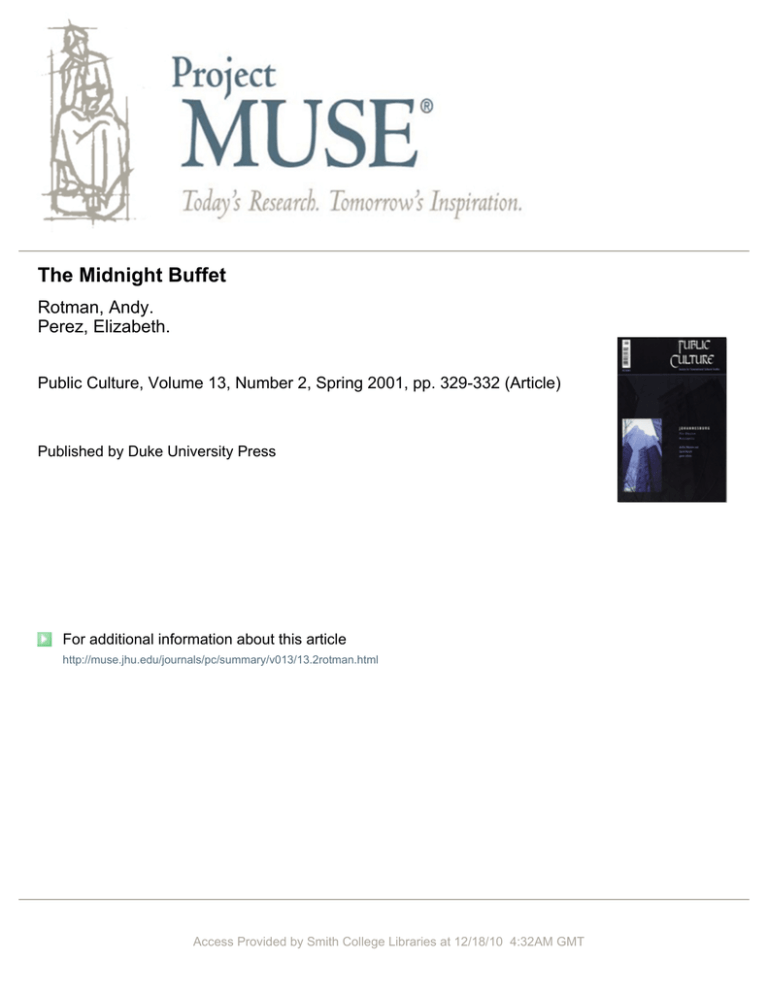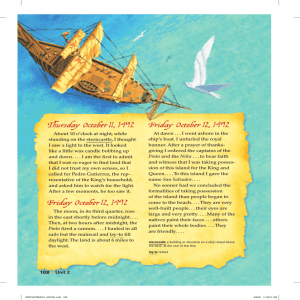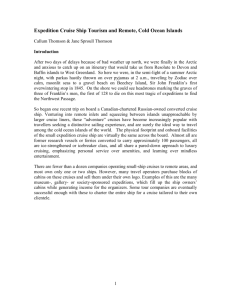The Midnight Buffet Rotman, Andy. Perez, Elizabeth.
advertisement

The Midnight Buffet Rotman, Andy. Perez, Elizabeth. Public Culture, Volume 13, Number 2, Spring 2001, pp. 329-332 (Article) Published by Duke University Press For additional information about this article http://muse.jhu.edu/journals/pc/summary/v013/13.2rotman.html Access Provided by Smith College Libraries at 12/18/10 4:32AM GMT PC 13.2-09 artworks 5/3/01 11:32 AM Page 329 The Midnight Buffet Andy Rotman and Elizabeth Pérez No one could resist the hard-boiled penguins, the egg fish with fins of carrot, and the fish eggs spooned out to resemble the ship’s pool. Standing between Styrofoam busts of Napoleon and Josephine, the head chef, a Swede, nodded in response to innumerable compliments. His staff had succeeded in creating sculpture from food and in transforming the cruise ship’s dining room into a floating museum. It was the fifth night of our European cruise—a gift from a generous parent— and we were accompanied by more than one thousand merchants who had received the trip as a business incentive. A queue of these passengers, many of whom wore formal attire, began to form by quarter past eleven, though the French doors would not swing open until midnight. Ushers informed them that during the first half hour of the midnight buffet the food was to be seen but not eaten. Inside, a windmill and a cannon fashioned from bread would greet them; so too would a Styrofoam Eiffel Tower and casually leaning Tower of Pisa. There would be vases carved from watermelon rind that resembled pieces of Venetian glass, game fowl carved from apples, Gaudí-inspired pastries, and numerous questions about the tools that had been used to craft the radish mice. It would be a sensorium of edible art, camera flashes, and compulsive eating; a race to consume, both visually and gustatorily, the icons of Europe and la bonne vie. Yet, embedded within this display of European taste and decorum, other flavors were also present. At both ends of the buffet, we detected a bovine presence — namely, matching cow and bull heads carved from butter and garlanded with fruit and vegetable flowers. The Scandinavian cruise ship employed 720 people from over fifty countries, but we had learned that many of the hundreds of members of the kitchen staff hailed from the Indian subcontinent, particularly from Goanese Christian communities on India’s west coast. Though the waiters, servers, sommeliers, and assistants had been hired from port cities throughout Asia, South America, and the poorer countries of Europe, ethnic difference was either put on the proverbial back burner or rendered palatable. During dinner one night, for example, our Romanian waiter and his Indian assistant joined the rest of the kitchen staff to entertain the guests, singing a few lusty verses of “O Sole Mio” in English, in what was described as “fifty-two different accents.” Australian and British staff members, nevertheless, stood closest to the microphones. Despite the multicultural character of the crew, the cruise catered primarily to travelers from the United States. The food presented at most dinners was pseudo329 PC 13.2-09 artworks Public Culture 5/3/01 11:32 AM Page 330 continental fare, tailored to North American palates and waistlines, complete with low-sodium minestrone and nonfat crème brûlées. One ship employee bore the lofty title of “foreign ambassador” and sat at a small, walnut-paneled table ringed with a United Nations of miniature flags. When we inquired what her job entailed, she answered that she assisted passengers who couldn’t understand English. Even the waitstaff used English as a lingua franca; notwithstanding the occasional Indian film song sung under a waiter’s breath as a table was being set, no other language was heard during meals or in public spaces. Many members of the waitstaff were young, with lofty aspirations, which ranged from completing medical school to sending money home to relatives who were finishing other professional degrees. No country could tax the crew’s wages; once on board, they became citizens of the vessel. In exchange for months of grueling hours, last-minute calls for overtime, and few moments of privacy in their shared rooms, the ship’s employees would receive free room and board and a healthy salary, though little free time to spend it. Crew members had few opportunities to leave the ship and indulge themselves; one such occasion did occur, though, when the ship arrived early in Barcelona. We invited our Romanian waiter to go dancing, and upon departure he was made to deposit his ship’s identification card as collateral with the only crew members obligated to remain on board — a core of Filipinos, the lowest group on the ship’s totem pole. The staff had no need of passports. The ship was their floating nation. In struggling to define the style of art represented by the midnight buffet, one may be attracted to the notion of kitsch, yet absolutely no irony was evident in the display or reception of its edible sculptures. In fact, the midnight buffet may have more in common with the Dutch still life, especially seventeenth-century pronk paintings (“pronk” meaning “to show off”), which offered lavish displays of food to the viewer in order to “lubricate man’s gaze amid his domain.”1 In any case, the cow and bull heads require a different interpretation. Made from butter — which along with milk, urine, dung, and curds constitute the ritually pure and purifying “five products of the cow” for many Indians — these divinely garlanded bovine heads physically bracket the midnight buffet. While this may suggest the midnight buffet as a sanctified arena, such a reading could hardly have been anticipated for the predominately American passengers on the ship. Since these bovine 1. Roland Barthes, “The World as Object,” in Calligram: Essays in New Art History from France, ed. Norman Bryson (Cambridge: Cambridge University Press, 1988), 108, quoted in Hal Foster, “The Art of Fetishism: Notes on Dutch Still Life,” in Fetishism as Cultural Discourse, ed. Emily Apter and William Pietz (Ithaca, N.Y.: Cornell University Press, 1993), 252. 330 PC 13.2-09 artworks 5/3/01 4:08 PM Page 331 heads were the only edible objects at the buffet that were never even tasted, their role was more performance than discourse, produced by and for the staff — perhaps in play but surely not in jest. Still, questions linger: To what extent does a visit to the midnight buffet, replete with its symbols of the cities that the ship had visited (or those that could and should be visited by a sister ship on the cruise line), constitute a visit to every site/sight in Europe worth eating? What are the logistics of such consumption by proxy? As an Indian parallel, consider the twelve jyotir lingas, or fiery phallus emblems of the god Shiva. Although these lingas of light are conventionally located in twelve different Indian cities, they have their counterparts in the city of Banaras so that by visiting the one, many locals claim, one can visit the other. Or better yet, as is inscribed on a souvenir plaque that contains representations of all twelve sites, a devotee can have darshan or an embodied visual engagement of all the jyotir lingas through darshan of this plaque. As one scholar has written, “the important thing about the location of these . . . is not that by being in one place they be visited more conveniently, but rather, by being in this one place, they need not be visited at all.”2 2. Diana L. Eck, Banaras: City of Light (New Delhi: Penguin Books, 1983), 293. 331 artworks PC 13.2-09 artworks 5/3/01 11:32 AM Page 332 Public Culture Andy Rotman teaches South Asian religions at Smith College and works on early Buddhist narratives. His translations from the Divine Legend [Divyāvadāna] are forthcoming in The Longman Anthology of World Literature. Elizabeth Pérez, a doctoral student at the University of Chicago Divinity School, conducts research on Caribbean religions of the African Diaspora. She has published poetry in El Coro: A Chorus of Latino and Latina Poetry (edited by Martín Espada, 1997) and elsewhere. 332




